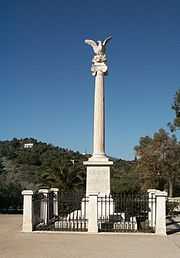Nea Epidavros
| Nea Epidavros Νέα Επίδαυρος | |
|---|---|
|
View of Nea Epidavros and its castle | |
 Nea Epidavros | |
|
Location within the region | |
| Coordinates: 37°40′N 23°09′E / 37.667°N 23.150°ECoordinates: 37°40′N 23°09′E / 37.667°N 23.150°E | |
| Country | Greece |
| Administrative region | Peloponnese |
| Regional unit | Argolis |
| Population (2011)[1] | |
| • Rural | 896 |
| Time zone | EET (UTC+2) |
| • Summer (DST) | EEST (UTC+3) |
| Vehicle registration | AP |
Nea Epidavros (Greek: Νέα Επίδαυρος) also written Nea Epidaurus is a village in Argolis regional unit, Greece. It is located in the east of Argolis peninsula, 40 km east of Nafplio. Epidavros is mainly known for First National Assembly that took place in Nea Epidavros in late 1821 and early 1822. The village is part of Epidavros municipality. Its population is 896 inhabitants according to 2011 census.
Description
The settlement is built in the interior part of a steep rock only few kilometres from the sea. This town is not visible from the sea, so the inhabitants were protected from Pirates in the old days. At the top of the rock is a medieval castle that dates back to the Byzantine period. The years before the Greek War of Independence, the village was named Piada. Between 20 December 1821 and 16 January 1822, the First National Assembly of the Greeks took place at Nea Epidavros (those days Piada). It was a national gathering of political representative of Greek revolutionaries. Today there is a monument in the central square of the village, dedicated to the first national assembly.[2]
An interesting place to see in Nea Epidavros is the medieval castle. Inside the castle is the maintained church of Agios Ioannis Theologos built in 11th century.[2] Near the village is the monastery of Agnountos. It dates from the Byzantine era and its style is fortress-like.[3]
Historical population
| Census | Settlement | Community |
|---|---|---|
| 1991 | 1,116 | |
| 2001 | 1,127 | 1,231 |
| 2011 | 896 | 987 |
Pictures
-

The Monument of the First Assembly
-

Description in the monument
References
- ↑ "Detailed census results 2011" (in Greek).
- ↑ 2.0 2.1 Νέα Επίδαυρος (in Greek). epidavros.gr. Retrieved 8 July 2014.
- ↑ "Ιερά μονή Αγνούντος". epidavros.gr. Retrieved 8 July 2014.
External links
| ||||||||||